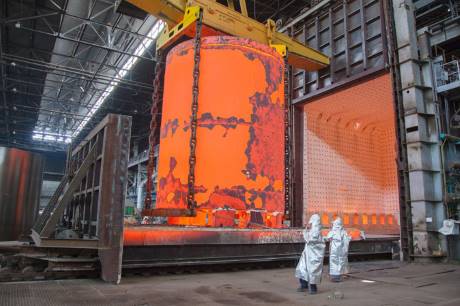A new 'ultra pure' nickel alloy has been used to create a reactor vessel, which Rosatom says could potentially last 120 years.
 |
| Rosatom says the extra strong vessel could last 120 years (Image: Rosatom) |
In a nuclear power plant the reactor pressure vessel contains the reactor core itself, demanding the highest resilience to temperature, pressure and radiation, while the component sits low in the reinforced centre of the concrete reactor building and is one of the only major components that cannot be replaced.
Russian state nuclear company Rosatom says it has developed a new 'extra strong' reactor pressure vessel for its forthcoming VVER-TOI pressurized water reactors. It could give that design a lifespan of 120 years, compared to the 100 years offered by Rosatom's current VVER-1200 as built at Novovoronezh and Leningrad Phase II.
Around the world a range of advanced reactor designs offer 60 year lives as standard, with this commonly expected to be extendable to 80 or 100 years. This represents a substantial improvement on the benchmark of 50-60 years for current reactors, which were usually licensed for an arbitrary 30 or 40 years when they were constructed in the second wave of nuclear build.
The first of the new parts was recently cast from a 450-tonne ingot and shaped into a weld-less shell 6 metres long and 4.5 metres in diameter, which "proves that OMZ SpetStal, supported by the Central Research Institute for Machine Building Technology, is now able to produce reactor shells of required dimensions and properties," according to Alexander Romashkin, acting deputy director of metallurgy associated with the Institute.
However, no decision has been taken on where to use the pilot vessel. It could potentially be used for new units at Akkuyu in Turkey or Kudankulam in India, said Romashkin. Other VVER-TOI units are planned for Kursk Phase II and Smolensk Phase II in the 2020s.
The next step, said Rosatom, will be to set up the same capability at its engineering subsidiary Atomenergomash.
Researched and written
by World Nuclear News




_18570.jpg)
_18938.jpg)
_33584.jpg)
_82983.jpg)





